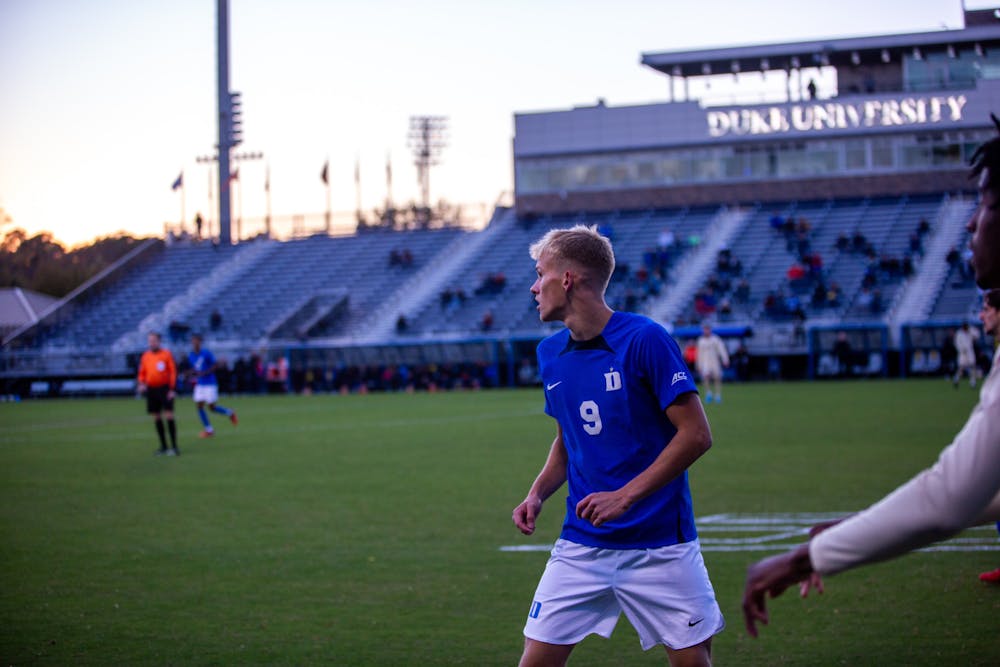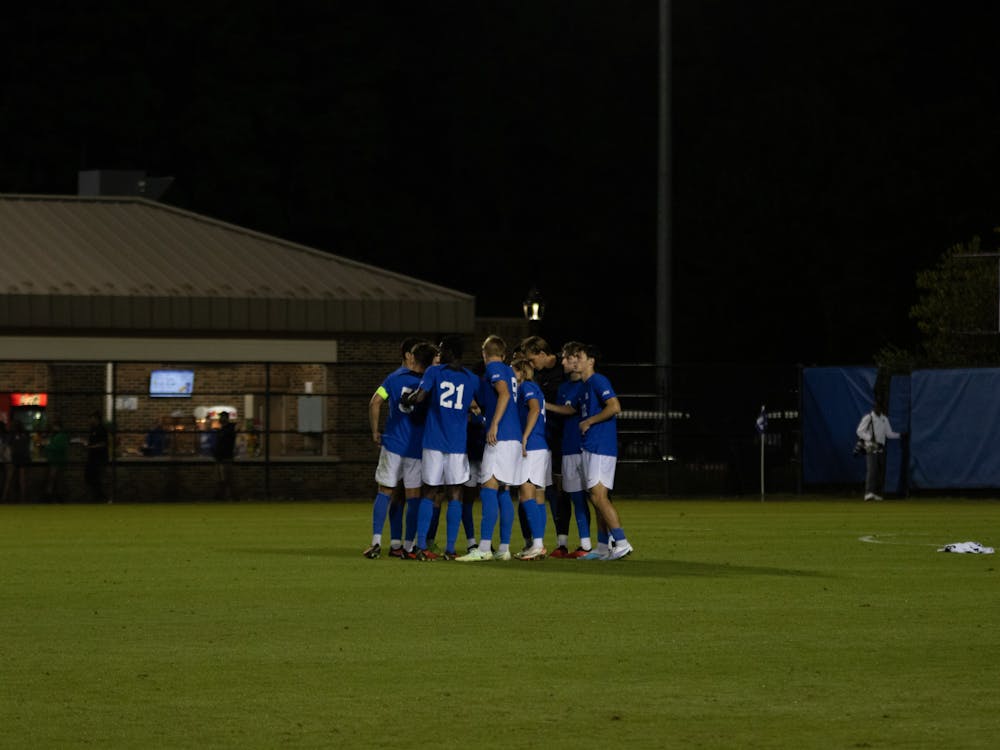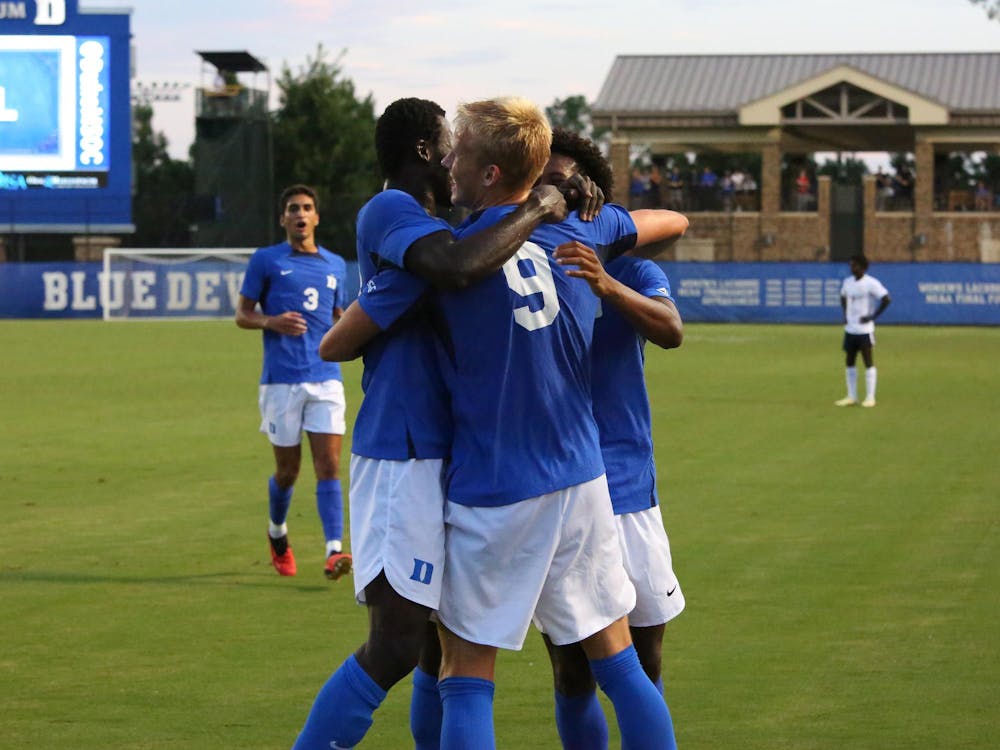On Oct. 10, 2023, Lewis McGarvey stepped onto the pitch at Koskinen Stadium for the first time in almost two years. Fans in the bleachers under Kennedy Tower cheered as the Belfast, Northern Ireland, product ran to his position at center back. But the noise that erupted from the sidelines and from the field was much louder, as the Blue Devils on the men’s soccer team hollered and whooped for their friend and captain.
That night, Duke swept unranked Elon 3-0 in a comfortable home game, worth watching more for what it represented than for any real concern about its outcome. After 60 minutes without a goal from either team, Ghana native Forster Ajago smashed a header into the net to put the Blue Devils ahead and to kickstart their collective hat trick. Despite a slow start, the game was easy money for Duke by its end.
McGarvey and Ajago were just two of six Blue Devils hailing from outside the United States on the 2023 men’s soccer roster. But cultural differences only enhance connection on Duke’s team. It's evident watching them all play: Passionate calls echo in accented English and sometimes even in Icelandic to make magic happen on the field.
In fact, sophomore Axel Gudbjornsson and freshman Ulfur Bjornsson use their shared native language, Icelandic, as a secret weapon. In practice, they work as a unit, beating their teammates in scrimmages by communicating to one another such that nobody else can understand. It might be frustrating for other Blue Devils while training, but it is certainly an asset in real competition.
Before they were teammates, however, Gudbjornsson and Bjornsson faced off as foes. Gudbjornsson, who hails from Reykjavik — the capital of Iceland — played for the club IF Fylkir through his youth career. Bjornsson, whose hometown of Hafnarfjörður sits just 15 minutes outside of Reykjavik, played for the rival club FH Hafnarfjörður, meaning the two boys would play each other a few times every year. It was always close, they both attested, though it is important to Bjornsson for it to be known that his team won their last hometown matchup.
Because of the local rivalry, it wasn’t until Bjornsson’s decision to follow Gudbjornsson’s college path that the two formed a real relationship.

“I made him help me with every step of the way of my Visa process,” Bjornsson joked to The Chronicle.
From that point, former rivals turned into friends and then teammates. Gudbjornsson shed his bright orange jersey and donned a Duke blue one; a year later, Bjornsson did the same with his black and white kit. What used to be a point of contention in mismatched colors is now the reason that the freshman striker and sophomore defender play with an extra zap of electricity in and around Koskinen Stadium.
Overseas origins
Being essentially born with a soccer ball at one’s feet is not unique to the kids of Iceland — on the contrary, American kids are something of an anomaly in that they are not indoctrinated into soccer. Growing up in Belfast, McGarvey, similarly to Bjornsson and Gudbjornsson, started kicking a ball around with his neighbors by age three or four, had started local training camps by age five and was a member of a club by 11.
“We just play every single night, we play soccer, on the street … and at school, every lunchtime, everyone's playing soccer,” McGarvey said. “It's just soccer, soccer, soccer, soccer, soccer. And every weekend you go watch the soccer game. And then if you win, you lose, you talk about the soccer game. Everything just revolves around soccer. And that's just life, just the way it is.”
Glentoran FC, McGarvey’s longtime club, carried the now-senior through the top tiers of youth soccer in Northern Ireland. He played and started for the U18 national team, where he was dubbed Player of the Year in 2018 and helped his team win the Centenary Shield — a tournament between U18 boys of the British Isles — in 2019. Before he was a Blue Devil, McGarvey wore a rooster, Glentoran’s crest, on his jersey.
In a city 4,760 miles away from McGarvey’s Belfast home, a young Ajago learned to kick a soccer ball as soon as he could walk, just like his fellow foreign teammates. In sunny Navrongo, Ghana — where the only real similarity to cold and cloudy Belfast is a similar obsession with the beautiful game — the future star striker began the journey that would eventually lead him to sign for the MLS’s Nashville SC.
Ajago never had any doubts about pursuing a professional career. It was just a matter of how he would go about it. His talents as a young player earned him a spot on the Black Starlets, Ghana’s U17 national team. From there, his path to professional soccer was definite, though the route was not yet clear. Should he pursue a professional league right away, or take the American route?
“My dad is someone that will push you,” Ajago said. “He helped me make a decision … he was like, ‘you got to go to school and play soccer.’”
So he did. Before he joined the MLS, Ajago was a college soccer powerhouse. He started his career at Delaware before transferring to Dayton and wrapping up his graduate year at Duke. In his victory-lap season, he earned ACC Offensive Player of the Year honors and was tabbed to the All-America Second Team after scoring 14 goals.
That 2023 campaign was when these four players — Gudbjornsson, Bjornsson, McGarvey and Ajago — turned the Blue Devils into more than a college sports team. It was a brotherhood, truly, and one that thrived on an international culture encouraged by the accepting community that soccer built for foreign student athletes. All 32 names on Duke’s roster lived and breathed the beautiful game, such that an amalgam of different nationalities not only fit into the team but actively built its chemistry.
“Having so many people from so many different places requires you to adjust to that new culture that you all share, being on the same team and working towards the same goals,” Gudbjornsson said.
Adjusting to America
The starkest differences on the Duke men’s soccer team may not be between each different nationality, but rather between the foreign contingent as a whole and the Americans.
“Football is the sport of the working class,” McGarvey said. “That's what everyone plays. It's cheap. All you need is your feet and the ball.”
He meant, of course, soccer, and in most countries except the United States.
“Here, it's more the sport of the upper class,” McGarvey continued. “It's expensive. You have to pay for your club, you have to travel everywhere. It’s just weird having that dynamic where it's not like everyone's pride and joy.”
“Soccer” might be an American word, but it is not, conventionally, an American sport. The World Cup is the most important sporting event to virtually every country in the world, whereas the Super Bowl unequivocally takes precedence primarily in the United States. Duke students, some of the nation’s most spirited college sports fans, rarely fill up the stands in Koskinen for soccer games, though they sleep in tents for weeks to attend a single basketball game. And McGarvey is right — it can cost thousands of dollars a year to put an American kid on a competitive travel soccer team and send them to summer training camps.
It’s not hard to imagine, then, that the transition to Durham from countries where soccer means everything is a markedly strange one. North Carolina didn’t even have an MLS team until Charlotte FC joined the league in 2022.
Which begs the question: How did Duke even end up on international radars? For the Icelanders, there was a precedent in the quasi-legendary form of Thorleifur Ulfarsson, who belonged to the same agency that helped Gudbjornsson and Bjornsson find their way to Durham. Ulfarsson was a MAC Hermann Trophy semifinalist in his second and final season with the Blue Devils and played for Houston Dynamo FC until the club recently announced his departure for Hungarian club Debreceni VSC.
“I think it's such a good opportunity … it's kind of the best of both worlds,” Gudbjornsson said.
For Ajago, the decision to come to Duke arrived as he decided to move on from Delaware and then Dayton. Pursuing college soccer in the United States is not unusual for players from Africa. Former Blue Devil Shakur Mohammed, a First Team All-American in 2022, also calls Ghana home. Mohammed now plays midfielder for Orlando City, so Ajago will have the chance to face him when their teams meet in the upcoming MLS season.
McGarvey’s choice to pursue an education at an American university was based on his family’s emphasis on academic rigor. He graduated from St. Malachy’s in Belfast at the very top of his class and was not ready to sacrifice his education — an inevitability if he had stayed in the UK for soccer. Despite extraordinary talent that could have placed McGarvey most anywhere he wanted after high school, Duke drew him in with its classic attractive quality of combining a top-tier athletics program with a similarly impressive academic reputation. It was the right call. He is in the process of applying to medical school.

Whatever their reasons for coming to Duke, and however happy they may have found themselves with the Blue Devils, there was a sizable adjustment to be made for Ajago, McGarvey, Gudbjornsson and Bjornsson. Where were the abundant soccer fans they grew up with? Why didn’t Premier League jerseys hang in dorm-room closets? Why was everybody so focused on the other kind of football?
“I think it's so strange,” McGarvey said. “Like it's so different.”
“It’s kind of weird,” Gudbjornsson said.
It’s so much hotter in Durham than in Northern Ireland and Iceland, too.
“It’s no joke adjusting,” Bjornsson said.
Soccer, and the team that it created, was the unifying, comforting factor for them all through the confusion of American adjustment. Soccer is a powerful force when it comes to unity. The 1.5 billion people from across the globe who watched the 2022 World Cup final can likely attest.
Different backgrounds, same heart
When Blue Devils jumped into each other's arms after their 5-3 victory against Syracuse (reigning national champions at the time) in September, the strange exclusion of soccer from American culture wasn’t on their minds. Collapsing in unison across the Koskinen field after a 2-1 loss in the NCAA tournament, culture clash was never a concern. When Ajago and five other teammates signed with MLS teams in December, leaving Duke behind, it meant, differences aside, the breaking up of a family.
On Jan. 15, the air in Belfast peaked at 34 degrees and the sky was covered in clouds. The high in still-sunny Navrongo was 102 degrees. Iceland was a frigid 11 degrees with exactly six hours of sunlight. In all three places, hundreds of kids kicked a soccer ball.
Ajago, McGarvey, Gudbjornsson and Bjornsson came to Durham having just one thing in common — with each other and with their American teammates. But there are few things in the world that bring people together the way soccer does.
“It's a very strong thing to have so many different cultures collide and combined into this one culture,” Gudbjornsson said.
A synthetic leather ball made these young men brothers.
Get The Chronicle straight to your inbox
Signup for our weekly newsletter. Cancel at any time.

Sophie Levenson is a Trinity sophomore and a sports managing editor of The Chronicle's 120th volume.

